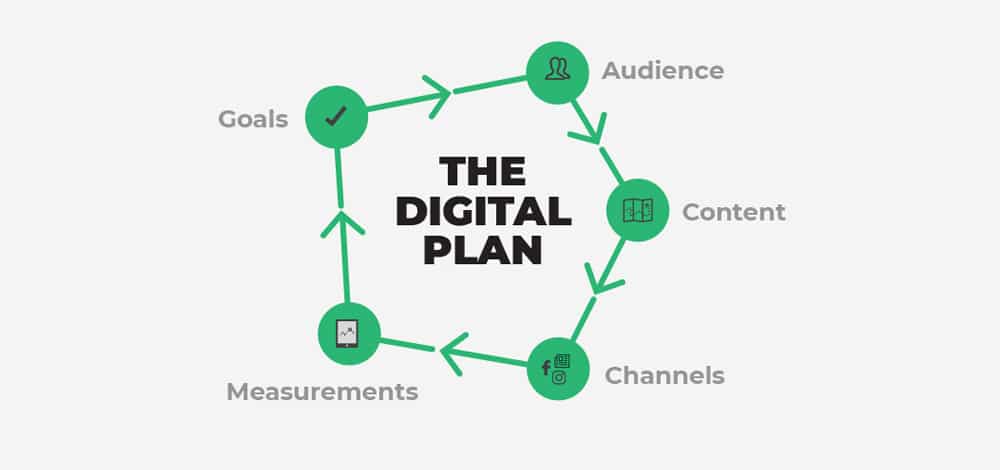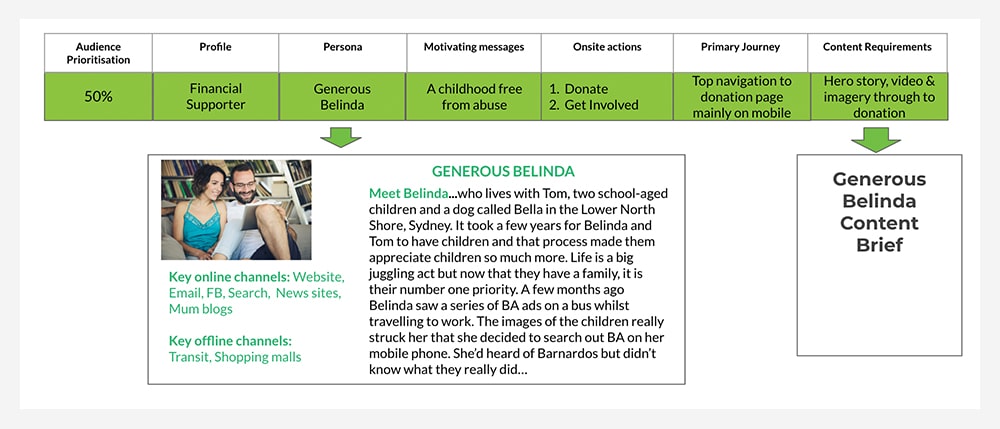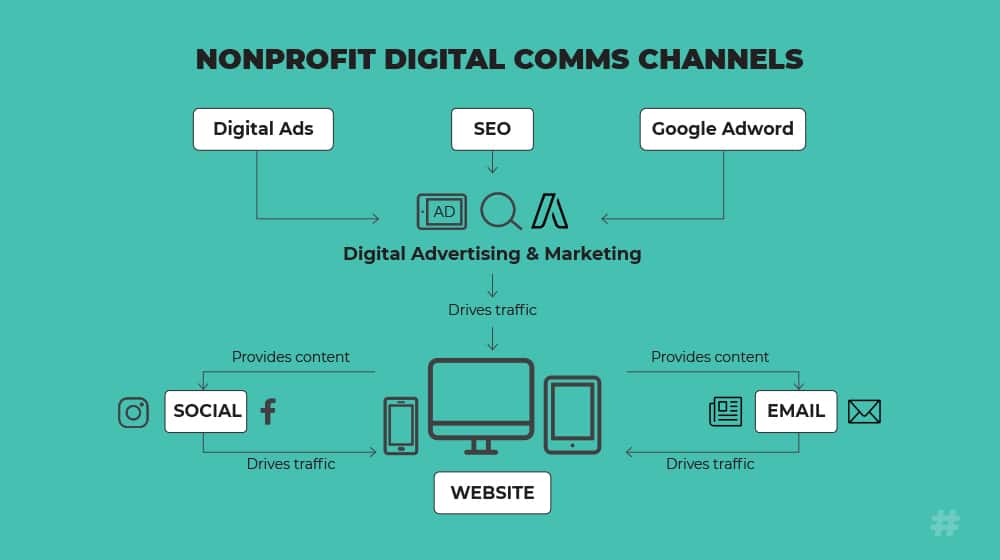Good digital strategy doesn’t have to be difficult
We know firsthand how difficult it can be to keep up with day to day digital tasks. From social media to email to your website, it can feel impossible to know that what you are actually doing is working.
This ‘impossible’ feeling (and if you’re reading this, then you’ve probably felt it too) is the inspiration for this blog.
Digital marketing and the technology that enables it is complex and ever-changing. We love being on the edge of that change especially when it involves a good cause. A solid overarching digital strategy can unite all your efforts and keep you on the front foot. It will make that impossible feeling a thing of the past.
Based on our conversations, almost all nonprofits are doing digital activities (yeah!) but more than 50% of them don’t have a digital strategy (oh no!)
We want to make crafting a digital strategy feel less complicated. And because a digital strategy is cyclical, crafting an initial framework can begin a cycle of continuous improvement and deliver results this year, and the years to come.
So, let’s simplify the process and break your digital strategy into five steps.

Download your step by step Digital Strategy Template
1. Capture your overarching nonprofit goals
Your organisation’s digital goals will serve as the foundation of the entire digital strategy. This should come as no surprise, but it’s important that your core team employs a more systematic approach to goal-defining than it might usually take.
Start by writing out your goals in somewhat general terms. Do you want to:
- Raise a certain amount of money?
- Increase awareness of your mission?
- Grow your audience or base of supporters?
- Increase a specific audience profile?
- Generate new leads?
Then put the SMART on your objectives. By that, we don’t mean a device but ensure your objectives are specific, measurable, actionable, relevant and time-orientated.
2. Define your audience and develop their personas
Creating a strategy that appeals to your audiences’ online behavior and interests starts with digging into your existing data. Use your website, Google Analytics, your CRM, and email management platform to identify and prioritise your existing audience.
Develop several distinct audience personas that your online supporters fit into. Can you quantify how valuable they are to you? What characteristics make them unique from other personas? Write a short description about their wants and needs as well as their online behaviour.
Defining these categories will help your audience become more human and therefore more meaningful to your team. In our experience, it helps you be more effective at attracting and converting them.
An example of turning a profile into a persona:

If this feels complicated (remembering that the title of this blog is an Uncomplicated Guide) then make a hypothesis that you can test and validate.
Better to start with some assumptions than none at all. We don’t live in a perfect world but we can improve it.
The most immediate way that supporter personas can benefit your nonprofit digital strategy is by helping you better align your brand with particular audiences. Think about the stories and tone that will resonate with these personas.
For instance, your email appeals to high-value donors, like Generous Belinda in the example above, would be very different from social media campaigns directed at a potentially new segment. Adjusting the tone of your appeals depending on the wants and needs of those audiences can drastically improve the effectiveness of your results.
3. Align messaging and content
Short, intentional multimedia vignettes and highly-shareable stories extend your nonprofit’s reach to new audiences of potential supporters and donors. Truly compelling stories, told in unique and digital-friendly ways, stand out above the rest and have buzz-worthy potential.
The modern organisation is also under pressure to tell stories in real time. These in-the-moment updates produce a powerful impact: your story, your team, or your cause can meet donors where they are already spending time online. By embracing real-time stories that show the direct impact of a donation, your organisation is far more prepared to connect with supporters.
But what stories should you tell?
We go back to our audience prioritisation. Data should be your first resource in learning more about your existing audience, but a large part of developing a new digital strategy involves refining you’re most motivating messaging to better target and attract specific new segments of online audiences, too.
An example of developing content based on your personas:

A great example of this is The Save the Children UK’s Most Shocking Second a Day video and follow up campaign. The charity’s primary audience is existing supporters. The objective of the campaign was to bring home the plight of children in countries like war-torn Syria to create awareness and engagement for the cause.
The video begins with a relatable British girl celebrating her birthday and then through a series one-second vignettes, we are transported through a complete refugee experience. The video is captivating and moving and has over 61 million views at the time of writing this blog.
You can’t produce such content with a clear understanding of your audience and what motivates them to respond
4. Define your channels and their roles
The most important digital communication channels to your organisation’s strategy will include your website, social media, email, and paid advertising. Here’s how they work together to drive traffic and engagement with your online campaigns:

-
- Your organisation’s website serves as the central hub for your digital strategy. It should be well designed, informative, useful, and fully integrated with your online fundraising and CRM platforms whenever possible. We can help you understand best practices for building nonprofit websites and integrating them, so please have a chat with us if you are thinking about this as part of your digital strategy.
- Social media platforms are essential for reaching wider audiences. Focusing on just a few of the most relevant platforms to promote your donation appeals, informational blog posts, and other digital content like videos and viral challenges is the smart way to go. Post content that encourages your followers to share and engage., and direct readers back to your website whenever possible in order to generate more traffic. You don’t have to have a big budget to be successful. Some great tips can be found in Social Media for Nonprofits: How to make an impact with a little budget.
- Email marketing is an essential part of the digital strategy equation. Use it to promote similar information-based content and donation appeals as you do on social media, but take special care to target your readers more closely. Your donor database is useful at this stage for segmenting your mailing lists, which can then boost open rates and click-through rates, increasing traffic to your website. Read Campaign Monitor’s 3 ways Nonprofit organisations can take advantage of email marketing.
- Digital advertising and other digital marketing strategies are important for increasing visibility outside of social media platforms. Online ads can direct viewers to your site and even re-target those who have visited your site in the past. Google Ads (available to nonprofits through Google Ad Grants) can significantly boost your site’s traffic flow. SEO techniques, when implemented into your website and blog posts, can also help boost your campaign’s visibility in organic search results.
5. Measure your success
Measuring the successes of your online fundraising campaign or other digital project is always essential, but it’s particularly important when you’ve put in so much thought and work into refreshing your overall digital marketing strategy. It all comes down to ensuring robust online tracking for your campaign.
The specific metrics that you’ll want to measure will depend on the nature of your campaign. Typical nonprofit conversion metrics include:
- Completed donations
- Email subscriptions.
- Pledge signatures
Your organisation has a wealth of data but it might be spread out over a few databases. So there’s one key question:
Is your data actionable?
The challenge is aggregating and translating information into valuable insights where and when you need it. Many organisations have data siloed across many departments in multiple content libraries.
Without a single “source of truth”, it’s likely that your employees find themselves on a wild goose chase looking for answers. Reporting tools that consolidate multiple data sources into a single set are essential for a modern organisation. Investing in data-driven tech that has a measurable ROI and will help you understand who is engaging with you and how. This provides you with powerful insights that fuel your digital strategy in the next cycle.
Wrapping Up
The digital landscape is an ever louder and busier place; competition for supporter and donor attention is at an all-time high. Without a unified digital strategy for your nonprofit, you risk losing focus, visibility and impact.
At Marlin, we embrace disruptive technologies that improve the ability for marketers and fundraisers to connect to their audience, tell stories and raise money for their cause. Feel free to call us for advice on what to think about for your own strategy.


